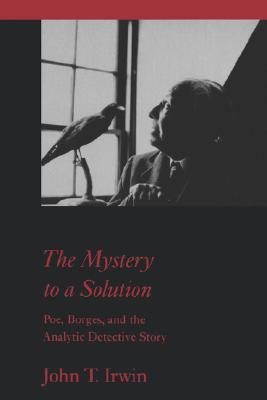The topic of Poe and Borges is as compelling as it is restricted, and Professor Irwin has made sure we understand that what is narrow may also be deep. Indeed, he peers through an aperture which in his perspective opens to take in a universe. But before I speak to that fullness of vision, perhaps a glance over the shoulder may be useful.
I have noticed laterally that Professor Harold Bloom, casting wide his net, has also had something to say recently about Poe and Borges in his transumption of hysteria and whimsy, The Western Canon: The Books and School of the Ages. In some words on the canonical American writers. Bloom has declared in what we may interpret as a repressed reference to his own works, “Poe is too universally accepted around the world to be excluded, though his writing is almost invariably atrocious.” On the other hand. Bloom celebrates the work of Jorge Luis Borges, though not convincingly, and in particular one Borgesian fable glossed by Irwin: “Death and the Compass.” Professor Irwin does not share Bloom’s estimate of Poe—far from it. He knows that “the care with which Poe constructed [a] passage in ‘The Murders in the Rue Morgue,’ indeed, suggests a poet’s attention to word and image,” and he is tireless in pursuing the implications of that thought.
Bloom and Irwin know what Borges himself declared: “The fact is that each writer creates his precursors.” But Borges owed so much to Poe, just as modern literature owes so much to Poe, that I cannot see him as a mere precursor of anyone, but rather as a puissant imaginative force in his own right. Irwin of course never deprecates Poe, but approaches him through Borges, and after an extensive exposition, circles back to where he began.
John T. Irwin has written notably about Poe before, in his American Hieroglyphics (1980), as well as about Faulkner in Doubling and Incest/Repetition and Revenge (1981). In a superficial sense, his Mystery to a Solution has a smaller topic than he has heretofore attacked, but his treatment of Borges and Poe is so wide-ranging in its references and so unrelenting in its unfolding of logical, psychological, and linguistic enigmas that it seems to be his biggest as well as his best production. Perhaps here I can merely indicate something of this book’s scope.
Strictly speaking, Irwin has set himself the limited task of showing the relationship of Borges’s three detective stories, “The Garden of Forking Paths,” “Death and the Compass,” and “Ion Hakkan al-Bokhari, Dead in His Labyrinth,” to Poe’s three stories of Monsieur C. Auguste Dupin, “The Murders in the Rue Morgue,” “The Mystery of Marie Roget,” and “The Purloined Letter.” In doing so, Irwin’s heroic quest for knowledge requires a labyrinthine tour of what we may think of as the ultimate canonical idol—Western civilization itself as expressed as an act of mind. This entails exploration of the Bible, Greek mythology, tragedy, and philosophy; of the logic of doubling, even and odd, handedness, and chess; of the history of mathematics and of the curricula of the École Polytechnique, Cambridge, the University of Virginia, and West Point; and ultimately of the ground on which Poe and Borges and Irwin meet. That locus, if I understand it, has to do with mirroring mirrors, with a dream within a dream as we recall it from Lewis Carroll. Here Pythagoras and Plato, Freud and Jung, and Poe and Borges seem to recur in an eternal Mobius strip that is at once history, literature, and intellect. Ultimately, what Irwin has addressed himself to is the nature of self-consciousness itself, and therefore the nature of mind and even humanity, rather than a matter of literary allusion and influence, or even literary self-referentiality.
And this is his triumph—his transcendence of his material by his thoroughgoing immersion in it. The Mystery to a Solution will join Daniel Hoffman’s Poe Poe Poe Poe Poe Poe Poe as a necessary study of one obvious topic, and it is the best book as well on Borges. But its readership should by no means be restricted to those fascinated by these authors. Irwin’s treatment of the primordial legends of Oedipus and Theseus is the most instructive and revealing I have ever seen, and alone justify the book. His mathematical and logical forays will appeal as well to those who know Douglas Hofstadter’s Gödel, Escher, Bach: An Eternal Golden Braid (1979). Above all, Irwin’s book will please all readers who require of a book that it exemplify its topic. After all, we have heard a lot in the last generation about the primacy of criticism, but rarely have we seen an example that would justify its most imperial claims. We cannot fail to notice that Irwin’s analysis of mind is a product of the mind of Irwin. Irwin’s practical and speculative criticism is itself an example of the thematization of the act of reading which he attributes to Poe’s fictions—”naming the story after the central symbolic object the story presents and . . . making that symbolic object a text.”
In other words, this study of self-referentiality is self-referential. I feel free to say so particularly because, first. Professor Irwin has himself noted his personal relationship with Jorge Luis Borges, and even included the record of his own best chess game, played against a man named Borges; and because, second, in the structure of his book he has acknowledged his own doublings, mirror-images, and labyrinthine recurrals. He has also indicated that he has books on F. Scott Fitzgerald and Hart Crane in progress. The evidence of The Mystery to a Solution is that there is already a growing circle of privileged readers waiting for them.
[The Mystery to a Solution: Poe, Borges, and the Analytic Detective Story, by John T. Irwin (Baltimore: The Johns Hopkins University Press) 481 pp., $36.95]

Leave a Reply